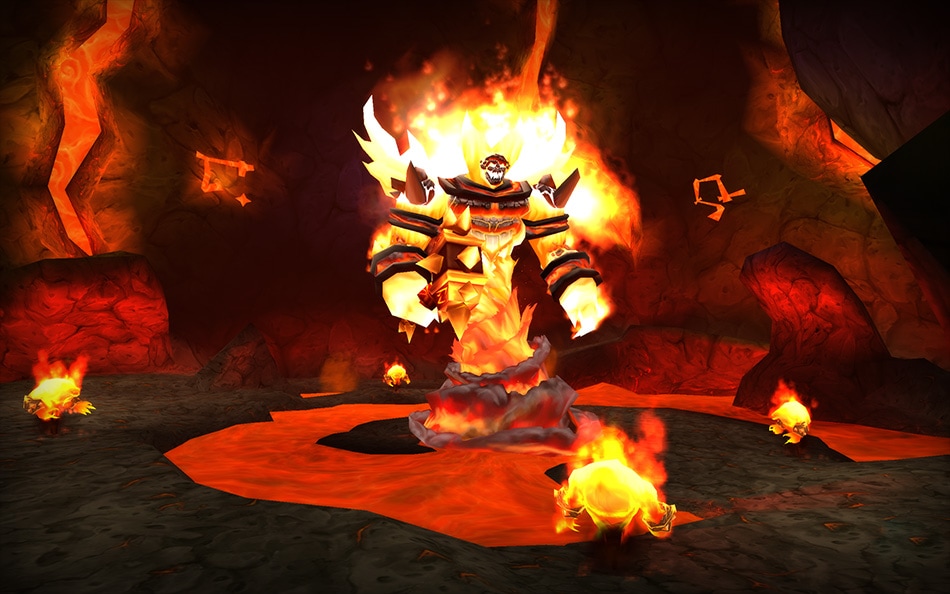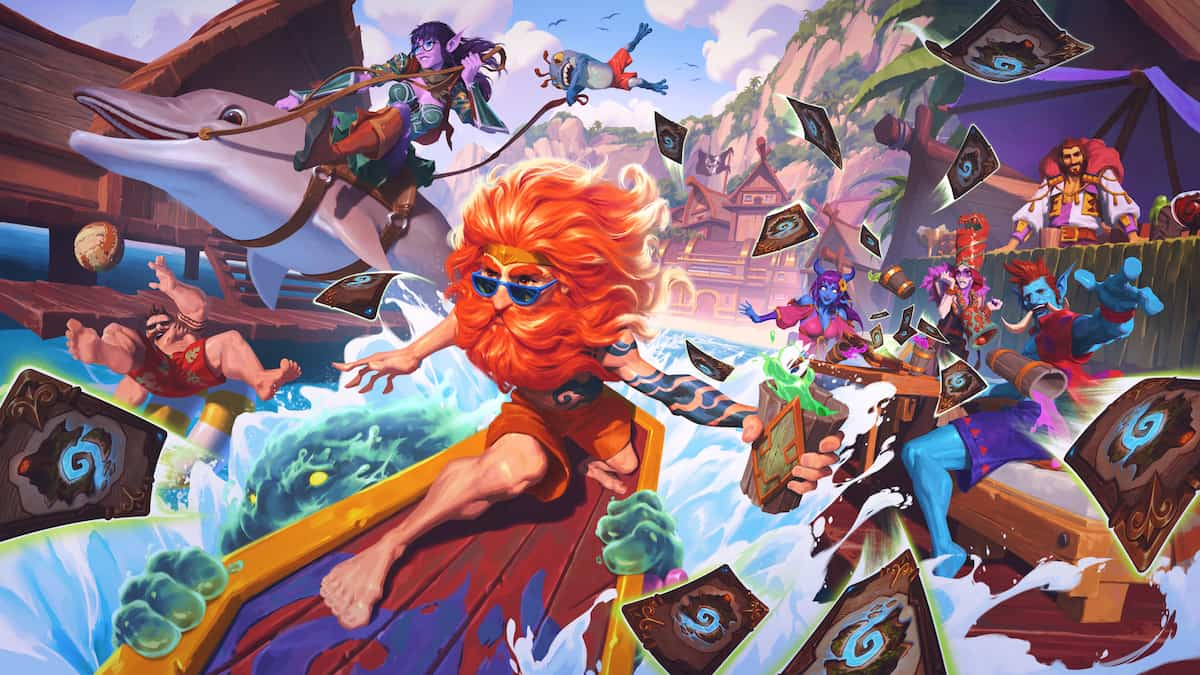In the southern half of the lands known as the Eastern Kingdoms, between the beautiful Redridge Mountains and the tranquil hills surrounding Loch Modan, sits a land that is an example of utter devastation.
Clay-red mountains and green hills give way to black ash and jagged obsidian peaks as one ventures into the twin regions of the Searing Gorge and the Burning Steppes, the former home to the ruins of the Dark Iron Dwarven kingdom’s rich mineral excavations and elemental abominations, and the later roamed by the remnants of the old, savage Horde and their dragonkin and ogre allies, amid of what little remains of the Dark Iron capital of Thaurissan.
And nested between these nightmarish regions lies the foreboding peak that originated them: the Blackrock Mountain.
The Birth of the Mountain
Many years before the orcs came into Azeroth through the Dark Portal, a civil war ravaged the dwarven lands around the Dwarven capital city of Ironforge. It culminated with the exile of two dwarven clans from their ancestral land – the Wildhammer Clan and the Dark Iron Clan. While the Bronzebeard clan kept their domination over the ancestral dwarven lands, the Wildhammers migrated to the north, to the frontier between the swampy Wetlands and the idyllic Loch Modan, where they founded the great city of Grim Batol, and the Dark Irons migrated to the southeast, settling in the Redridge Mountains and building a city named after their emperor, the Sorcerer-Thane Thaurissan.

But while the war left deep scars in the relationships between the three clans, the Dark Irons were especially vexed, and started developing paranoia, believing it to be only a matter of time until the other two clans would unite again and try to take their newly-founded kingdom away from them. And so, shortly after the civil war, the Dark Irons set out as twin armies to crush their cousins before they could strike at them. This became known as the War of the Three Hammers.
The Sorcerer-Thane lead an army to Ironforge, while his wife, Queen Modgud, lead her army to Grim Batol. But both armies were routed, and, while Modgud managed to use her sorceress powers to make Grim Batol uninhabitable and so at least strike a pyrrhic victory against the Wildhammers, Thaurissan saw himself driven back in complete defeat.
To make matters worse, ironically, the attack had forced the dwarven clans to set aside their differences and work together against the common foe, and so the retreating Dark Irons found themselves being pursued by their enraged cousins.

In order to turn the tide of battle, the Sorcerer-Thane gathered his most powerful spellcasters and began an ancient ritual to summon the elemental ragnaros-the-firelord.
This, it turns out, was a poor decision.
ragnaros-the-firelord burst forth from the elemental plane with such violence that a volcano erupted around him, immediately laying waste to the majority of the Redridge Mountains and shattering the Dark Iron capital, as well as razing most of what was left of their army.
Such was the destruction that both the Bronzebeards and the Wildhammers immediately retreated, leaving the Dark Irons to their fate – being dragged underground to be ragnaros-the-firelord’s slaves deep within the bowels of his volcano.
A volcano that became known as Blackrock Mountain.
Claimed For The Horde
Many years passed, and few dared travel to the darkened lands that had once been part of Redridge. ragnaros-the-firelord, despite ruling over the Dark Irons, could find no way to break the original spell and return to his home in the elemental plane, The Firelands, so he settled for building his kingdom and forces below ground, so that one day he would rise to conquer the surface kingdoms.

In the meantime, the orcs surged through the Dark Portal, and, seeing as most of the elemental threats were underground, decided to take the upper levels of the mountain as their base of operations.
So it was there that, come the Second War, Orgrim Doomhammer had his seat of command. And it was at Blackrock Mountain that the Alliance struck in the final battle against the Horde.
This battle became known as the Assault on Blackrock Spire, and is one of the pivotal events in Azeroth’s history, culminating with the death of the great paladin commander Anduin Lothar (the priest Hero’s namesake), the scattering of the original Horde, and the defeat and capture of its legendary leader, Orgrim Doomhammer – as well as setting in movement the events that would lead to the Alliance’s invasion of Draenor through the Dark Portal, and the creation of the legendary blade, the ashbringer.

But the evil permeating these lands was not so easily dispersed, and as the Alliance left to tend to its own lands, leaving only token garrisons and watch posts in the conquered areas, soon the remnants of the Horde retook their old haunts, even if they were too few and disorganized to pose a threat to the Alliance.
So while, to this day, players passing through the devastated lands can still see standing the great statue erected in honor to Anduin Lothar, the mighty paladin pointing his sword at the mountain, so too they will observe that the land surrounding is crawling with black dragonkin, stray orcs and savage ogres.
And atop the mountain, the quarters once occupied by Doomhammer are now home to the lord of the Black Dragonflight, nefarian, who gathered the stray orcs as his servants, placing them under the command of one of Doomhammer’s surviving lieutenants, rend-blackhand.
Into the Depths
Of all the dungeons found within Blackrock Mountain, Blackrock Depths was usually the first to be visited. Players were often called to brave the Dark Iron Kingdom to either rescue Magni Bronzebeard’s daughter Moira, or to save Alliance Marshal Windsor so that we could unmask onyxia’s schemes in the Stormwind Court.

This dungeon was unique, not only due to its size – where its Hearthstone counterpart makes the player face three boss encounters, World of Warcraft players could pit themselves against up to nineteen bosses – but also due to the fact that its layout was mostly that of a capital city, much like Orgrimmar or Stormwind. Indeed, one could even find resting areas – like the infamous Grim Guzzler tavern – where the inhabitants would not attack without provocation.
Incidentally, this was where one of the adventure’s most famous cards – the grim-patron – takes inspiration for its mechanic. The Grim Guzzler was often so tightly packed with neutral Dark Iron dwarves that collateral damage during a fight was almost always inevitable, stray shots frequently hitting bystanders and pulling them into the fight.
The final showdown with the Emperor of the Dark Irons, in the meantime – himself a descendant of the Sorcerer-Thane that is his namesake – was originally a balancing act much like the Hearthstone fight. Players were faced with both Dagran Thaurissan and his hostage-turned-lover Moira Bronzebeard. Killing Moira would result in Dagran enraging and becoming nearly impossible to kill unless the player characters were above the recommended level for the dungeon. So the party needed to employ a strategy that would keep Moira at bay while dealing with the Emperor.

Sadly, when the dungeon was restructured following the Cataclysm, the fight was greatly simplified.
Story-wise, it’s still an important point in the Warcraft universe, as it is revealed that Moira was not held against her will, but in fact in love with Dagran and carrying his son – making her unborn child the future ruler of both Ironforge and Shadowforge, a potential unificator for the long-estranged Dwarven Clans.
Since Dagran’s death – that much like Medivh’s, was officially retold in novel form with little to no player participation – she has claimed her father’s seat in the Throne of Ironforge, replacing the monarchy with a council where a representative of each clan sits, further paving the way for a possible dwarven reunification. Despite her peace-making goals, she is visibly embittered from having lost the father of her child.
The Mountain’s Core
Deep within the mountain, lie the fiery followers of the Firelord himself, in what amounts to a gigantic cave network with similarly gigantic foes.
Originally accessible through the previous dungeon, Blackrock Depths – where players could find a portal to the Molten Core – a quest would later enable players to teleport from the center of Blackrock Mountain to Ragnaros’ domain.
Here was the first of World of Warcraft’s end-game dungeons, an affair that required tight cooperation between forty players to navigate. The difficulty was brutal, as badly-managed pairs of molten-giants and core-hounds were enough to wipe out the player army right upon entering.

The players had to fight through not only those beasts, but ragnaros-the-firelords lieutenants as well, extinguishing the magical runes they guarded in order to summon the Firelord from his fiery repose.
Contrary to most other dungeons, though, there was not a huge lore incentive to pit the players against these supernatural foes. Sure, there was the slight feeling that they were up to no good – but seriously, after hundreds of years of building up their strength underground, one would think that the Firelord’s forces would have committed some kind of act of aggression by the time the Third War was done.
No, the greatest motivation for the hours upon hours of struggle in Molten Core was pure greed – the rare epic equipment and weapons that Ragnaros and his ilk dropped when defeated. In current day World of Warcraft, epic-quality items come by relatively easy, but in the beginning, only those truly dedicated could hope to parade in Ironforge’s main plaza, fully decked in epic gear.

The fight with Ragnaros was suitably epic, taking place amid a pool of molten lava and fiery geysers, the foe too big to even fit most player’s screens. The rewards were suitably epic, too – the most powerful weapons in the game, and the pieces to forge that which would for many years be the greatest status-symbol a player could carry: ragnaros-the-firelord’s hammer, Sulfuras, at the time the only legendary-quality item existent in-game.
Upon defeat, the Firelord would melt into the lava-pool from which he had spawned, leaving only his huge hammer behind to mark his grave. Little did the players know that he had merely be banished back to his home plane, where he plotted his revenge up until the Cataclysm…
Conclusion
And thus ends the story about how Warcraft’s most famous mountain came to be, and the adventures to be had in its lower reaches.
Oh, but what about all the dragons, you say? Well, sit on tight, as in the next Flavor Text and Lore, we will ascend into the upper reaches of the mountain, the domain of the Black Dragonflight and its masters…





Published: Feb 13, 2016 10:07 pm